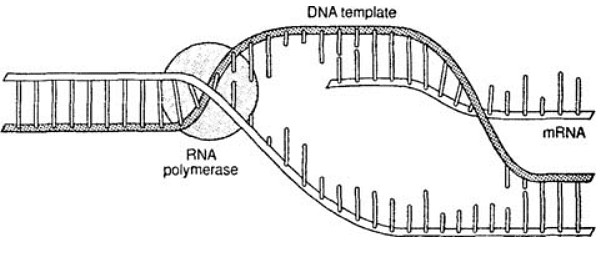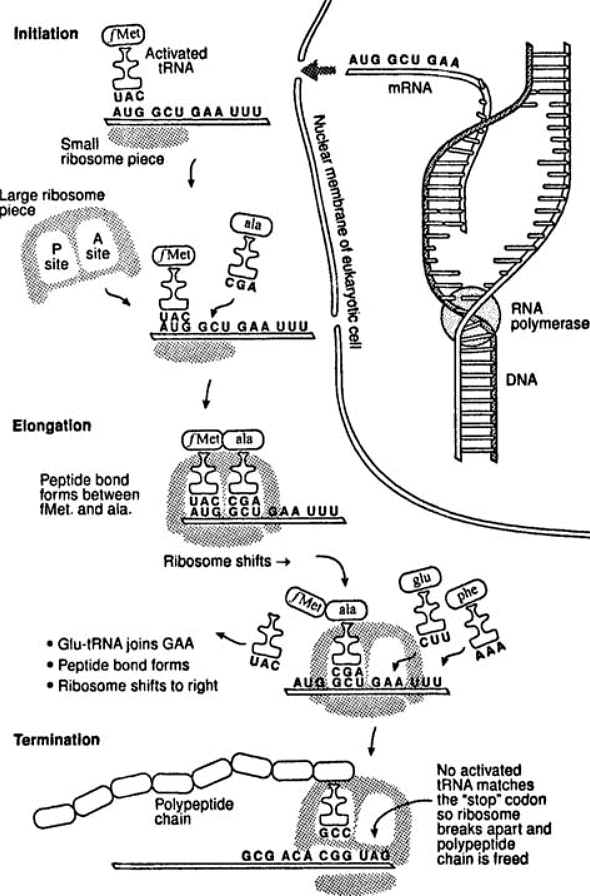Protein Synthesis | Anthropology Optional for UPSC PDF Download
Introduction
- During the 1950s and 1960s, it was discovered that DNA plays a crucial role in protein synthesis. Proteins are essential for various cellular functions, including providing structural support, acting as enzymes, and participating in specialized activities, such as bacterial flagella and pili formation.
- The genetic code is central to protein synthesis, as it dictates the sequence of amino acids in proteins. This code is found in the DNA's nitrogenous bases, and the specific arrangement of these bases determines the unique amino acid sequence of each protein.
- To synthesize proteins, several key components must be present. These include a supply of the 20 amino acids that compose most proteins, enzymes that facilitate the process, DNA, and another type of nucleic acid called ribonucleic acid (RNA). RNA is responsible for carrying genetic information from DNA in the cell nucleus to the cytoplasm, where protein synthesis takes place.
- RNA is similar to DNA but has three main differences: it contains ribose instead of deoxyribose, its nucleotides have uracil instead of thymine, and it is typically single-stranded. Understanding how the genetic code in DNA is translated into amino acid sequences in proteins is fundamental to the process of protein synthesis.
Types of RNA
In the synthesis of protein, three types of RNA are required.
- The first is called ribosomal RNA (rRNA) and is used to manufacture ribosomes. Ribosomes are ultramicroscopic particles of rRNA and protein where amino acids are linked to one another during the synthesis of proteins. Ribosomes may exist along the membranes of the endoplasmic reticulum in eukaryotic cells or free in the cytoplasm of prokaryotic cells.
- A second important type of RNA is transfer RNA (tRNA), which is used to carry amino acids to the ribosomes for protein synthesis. Molecules of tRNA exist free in the cytoplasm of cells. When protein synthesis is taking place, enzymes link tRNA to amino acids in a highly specific manner.
- The third form of RNA is messenger RNA (mRNA), which receives the genetic code from DNA and carries it into the cytoplasm where protein synthesis takes place. In this way, a genetic code in the DNA can be used to synthesize a protein at a distant location at the ribosome. The synthesis of mRNA, tRNA, and rRNA is accomplished by an enzyme called RNA polymerase.
Transcription
- Transcription is a critical initial step in the process of protein synthesis. During this process, a strand of mRNA is created using the genetic information contained within DNA. The enzyme RNA polymerase attaches to a specific region of the DNA molecule, unwinding the double helix structure (leaving one strand unused). As the enzyme moves along the DNA strand, it selects complementary bases from available nucleotides and arranges them within an mRNA molecule based on the principle of complementary base pairing (Figure). The mRNA chain continues to grow until a stop signal is encountered.

- The genetic information within the DNA strands is read in groups of three nucleotides, referred to as codons. A codon might be represented by any combination of the four bases, such as CGA, TTA, GCT, or another sequence, depending on their arrangement within the DNA strand. Consequently, the resulting mRNA molecule is composed of a series of codons derived from the genetic message embedded in the DNA.
- Upon reaching the stop codon, the mRNA molecule detaches from the DNA molecule, which subsequently reverts to its double helix form. Simultaneously, the mRNA molecule travels through the cell's cytoplasm towards the ribosomes.
Translation
Translation is a crucial process in which the genetic information is converted into an amino acid sequence to form a protein. This process occurs at the ribosome and involves three key molecules: mRNA, tRNA, and amino acids.
- Firstly, the mRNA molecule, which is synthesized from DNA and carries the genetic code, reaches the ribosome. Meanwhile, tRNA molecules, each carrying a specific amino acid, prepare to transport their amino acids to the ribosome.
- The mRNA molecule then displays its genetic information in groups of three bases, known as codons. Each codon has a corresponding anticodon on a tRNA molecule. When the mRNA codon and the tRNA anticodon pair up, the tRNA molecule deposits its amino acid at that position. This process continues, with each subsequent codon on the mRNA molecule attracting a tRNA molecule carrying the appropriate amino acid, and the amino acids are linked together in a chain.

- The ribosome advances along the mRNA molecule, exposing new codons and adding more amino acids to the growing protein chain. The sequence of codons on the mRNA directly dictates the amino acid sequence of the resulting protein.
- Once the protein synthesis is complete, the protein is released from the ribosome and undergoes further processing. In eukaryotic cells, it may be stored in the Golgi body before being released, while in bacteria, it could be released as a toxin. The mRNA molecule is then broken down, and its nucleotides are recycled. The tRNA molecules return to the cytoplasm to collect new amino acids, and the ribosome is ready for the arrival of another mRNA molecule.
In summary, translation is the process of converting genetic information in mRNA into a specific sequence of amino acids to form a protein. This process occurs at the ribosome and involves the interaction of mRNA, tRNA, and amino acids, ultimately determining the protein's structure and function.
Gene Control
- The process of gene expression, which involves protein synthesis, is not continuous but occurs at intervals with periods of genetic inactivity. This indicates that cells regulate and control gene expression.
- There are several levels at which gene expression can be controlled in cells. For instance, genes are rarely active during mitosis. Additionally, gene control can occur during transcription, where specific DNA segments enhance the activity of nearby genes. Furthermore, after transcription, the mRNA molecule can undergo modifications to regulate gene activity. It has been discovered that eukaryotic mRNA consists of unnecessary RNA segments, known as introns, which are removed during the production of the final mRNA molecule. The remaining mRNA segments, called exons, are then spliced together to form the final mRNA molecule. Bacterial mRNA, on the other hand, lacks introns.
- Gene control has been extensively studied in bacteria, where genes have been classified as structural genes, regulator genes, and control regions. These three units together form a functional unit called the operon.
- In certain bacteria, the operon has been closely examined, revealing that specific carbohydrates can induce the production of enzymes required to digest those carbohydrates. For example, when lactose is present, bacteria synthesize the enzymes necessary to break it down. Lactose functions as an inducer molecule in the following manner: In the absence of lactose, a regulator gene produces a repressor protein, which binds to a control region known as the operator site. This binding inhibits the structural genes from encoding the enzyme responsible for lactose digestion. However, when lactose is present, it binds to the repressor protein and removes the repressor from the operator site. With the operator site unoccupied, the structural genes are free to produce their lactose-digesting enzyme.
Conclusion
Protein synthesis is an essential cellular process that involves the conversion of genetic information stored in DNA into functional proteins. This process requires three types of RNA, namely ribosomal RNA (rRNA), transfer RNA (tRNA), and messenger RNA (mRNA). Protein synthesis occurs via two main stages: transcription, which creates an mRNA molecule that carries the genetic code from DNA, and translation, where the genetic information in mRNA is converted into a specific sequence of amino acids to form a protein. Gene control is essential in regulating gene expression, and it can occur at various levels. In bacteria, the operon model helps illustrate how gene control can be induced or repressed in response to specific environmental conditions, such as the presence or absence of specific carbohydrates. Overall, understanding protein synthesis and gene control is crucial for understanding the fundamental processes that govern cellular function and life.
Frequently Asked Questions (FAQs) for Protein Synthesis
 |
Download the notes
Protein Synthesis
|
Download as PDF |
What are the three types of RNA involved in protein synthesis?
The three types of RNA involved in protein synthesis are ribosomal RNA (rRNA), transfer RNA (tRNA), and messenger RNA (mRNA). rRNA is used to manufacture ribosomes, tRNA carries amino acids to the ribosomes for protein synthesis, and mRNA receives the genetic code from DNA and carries it into the cytoplasm where protein synthesis takes place.
What is the difference between transcription and translation in protein synthesis?
Transcription is the initial step in protein synthesis, during which a strand of mRNA is created using the genetic information contained within DNA. Translation is the process of converting the genetic information in mRNA into a specific sequence of amino acids to form a protein. This process occurs at the ribosome and involves mRNA, tRNA, and amino acids.
What is the role of codons and anticodons in protein synthesis?
Codons are groups of three nucleotides in mRNA that carry the genetic information for a specific amino acid. Anticodons are complementary sequences of three nucleotides on tRNA molecules. During translation, the mRNA codon pairs with the tRNA anticodon, allowing the tRNA molecule to deposit its amino acid at the corresponding position. This process ultimately dictates the amino acid sequence of the resulting protein.
How is gene expression controlled in cells?
Gene expression can be controlled at several levels in cells. For example, genes can be regulated during transcription, where specific DNA segments enhance the activity of nearby genes. After transcription, the mRNA molecule can undergo modifications to regulate gene activity, such as the removal of introns and splicing together exons. In bacteria, gene control can be observed in the operon system, where the presence or absence of certain molecules can induce or inhibit the production of specific enzymes.
|
108 videos|243 docs
|

















